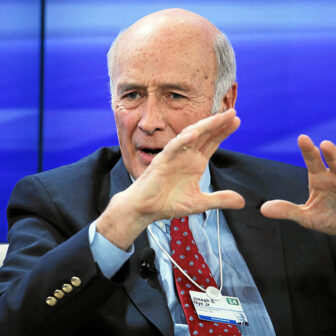MUCH of the debate about the future of primary healthcare in Australia has been dominated by unseemly professional tussles over the roles and influence of GPs, nurses and pharmacists. So it’s not surprising that one of the major points of contention surrounding the new primary healthcare organisations known as Medicare Locals has been the question of who will run them, with the Australian Medical Association agitating loudly for a “leadership role” for GPs.
Those interested in developing a more community-centred approach – and it’s to be hoped that this group might include those involved with the first batch of Medicare Locals announced this week – could do worse than take a trip to the tough northern suburbs of Philadelphia, just a short train ride from New York City.
There they will find an innovative community health centre that is receiving increasing recognition within the United States: the 11th Street Family Health Services Center. Located in a poor neighbourhood, with mostly African-American residents living in public housing, the service was recently described in the journal Health Affairs as an example of the future of primary healthcare.
The product of a fifteen-year partnership between nursing leaders at Drexel University and local residents, the service operates quite differently from how many people – particularly those used to a medical model – have traditionally conceived of healthcare.
From the outset, the public health nurses involved have been committed to developing long-term relationships with the community and finding out what they perceive as their health problems and want from their healthcare. “We knew what the major health issues were – diabetes, hypertension, obesity, mental health, violence, substance abuse,” says Patricia Gerrity, Drexel’s associate dean for community programs. “But if I’d just set up programs for those, nobody would have come.”
Professor Gerrity has been involved in developing the service since 1996, when she and colleagues spent three solid days with more than one hundred residents, brainstorming a vision for their health service. What the people wanted, it turned out, was not only good clinical care but also opportunities for learning about how to look after their own health, and a focus on wellness rather than disease. They also wanted a service that respected confidentiality and privacy, especially if it was going to employ locals.
The result, after some years of grant applications and project development, is a health centre that also includes a kitchen for cooking classes, a state-of-the-art fitness centre where locals and staff attend yoga classes, and other common spaces for health promotion activities such as art therapy, chronic disease management programs, mindfulness meditation and smoking cessation classes.
The services are provided not by doctors but by nurse practitioners working closely with behavioural health consultants and health educators. The centre also has a fitness trainer, dentists, social workers, couple and family therapists, creative arts and physical therapists, and a complementary and integrative therapist who does massage, Reiki, and Qi Gong.
Professor Gerrity, who recently described the service at an Association of Health Care Journalists conference in Philadelphia, says the complementary and integrative therapist has become a vital part of the team, and also looks after the staff. “The complementary and integrative care therapist has become essential to the Center’s staff for helping to maintain a sense of peace and serenity and for setting a tone of mindfulness and positive energy,” she says.
11th Street has also sent a social worker, a clinical nurse and a patient to the famous Stanford Patient Education Research Center for training in how to run self-management programs for people with chronic illness.
As often happens in places where people lead chaotic lives, the traditional appointments system did not work. So the centre changed to an “open access” system where patients are guaranteed same-day appointments. The number of patients increased immediately and there were fewer missed appointments.
But when it all began, one of the biggest barriers Professor Gerrity and colleagues faced was the residents’ lack of trust. Over the years, they had seen so many researchers come, describe the extent of their health problems, and go, without doing anything to help fix them. A similar complaint is often heard from Indigenous communities in Australia.
“I had to gain trust,” says Professor Gerrity. She and her colleagues spent more than a year consulting with the local community before the brainstorming session.
“The problems they raised really surprised us,” she says. “At one housing development, they were concerned about being hit by cars. We got a stop sign put in where they wanted. They felt we really listened.
“At another place, people were concerned about dog bites. So we got the health department to round up the stray dogs. At another place they wanted to do CPR because there was violence and one woman’s son had died in her arms. They were the things we did over the first year and a half, and we gained trust because we were working on their agenda not ours.”
As the years passed, Professor Gerrity and colleagues became increasingly aware of the pervasive impact of trauma, and how this can shape early childhood experiences – and thus long-term health – when families are stressed. Their clinical observations have subsequently been confirmed by research that replicated the findings of the Adverse Childhood Experience study, which was profiled recently in the New Yorker.
Staff members are now trained in trauma, and much of the centre’s work with families aims to support the development of positive relationships between mothers and babies. One program provides support from an interdisciplinary team that tracks women from pregnancy through their baby’s first three years. This involves home visits as well as group sessions.
“Through careful listening and observation, the team can identify parental stressors that might be affecting parenting,” Professor Gerrity says. “This approach results in early identification of developmental, behavioural, and health problems... identifying and treating early can greatly improve children’s chances of reaching their full potential.”
The centre’s work extends way beyond its walls. It is involved in a program that provides free fresh produce to local families, while the vacant lot next door has been transformed into an urban farm. The farm creates jobs for vulnerable youth, and the produce is used in the centre’s cooking classes and is made available at low cost to patients. As Professor Gerrity wrote in a recent article, “Today, 11th Street Family Health Services of Drexel University anchors the renaissance of a neighbourhood once considered an example of urban decay.”
Professor Gerrity has received many accolades and is often called on to show visitors from across the country around the centre. While she has spent much of the past fifteen years writing grant applications to various government and non-government funding agencies to finance the service, she now plans to focus more on evaluating its impact on the community’s health and broader healthcare costs.
Since the centre opened in its purpose-built premises in September 2002 (previously it was in temporary accommodation), the number of primary care visits grew from 2200 in 2003 to over 14,000 in 2009. Visits to its behavioural health services grew from 210 in 2003 to 5653 in 2009. Dental services had 944 visits in 2005, which grew to 5586 in 2009.
As well as an electronic medical record, the centre has developed a “patient wellness tracker,” which not only keeps tabs on symptoms and disease control, but also gathers data on quality of life and healthy behaviours.
Looking back, Professor Gerrity wishes their building had been designed differently, to allow for the expansion that has occurred. But otherwise, she says, one of the main lessons from the 11th Street experience is to avoid the traditional medical model of care.
“In traditional medical care, the question asked is, ‘What is wrong with this person?’ and they look at a diagnosis,” she says. “We try to say, ‘Who is this person and what has happened to this person?’ We find out how to help them in body, mind and spirit.” She laughs and adds, “I wish I could get my healthcare here.” •




